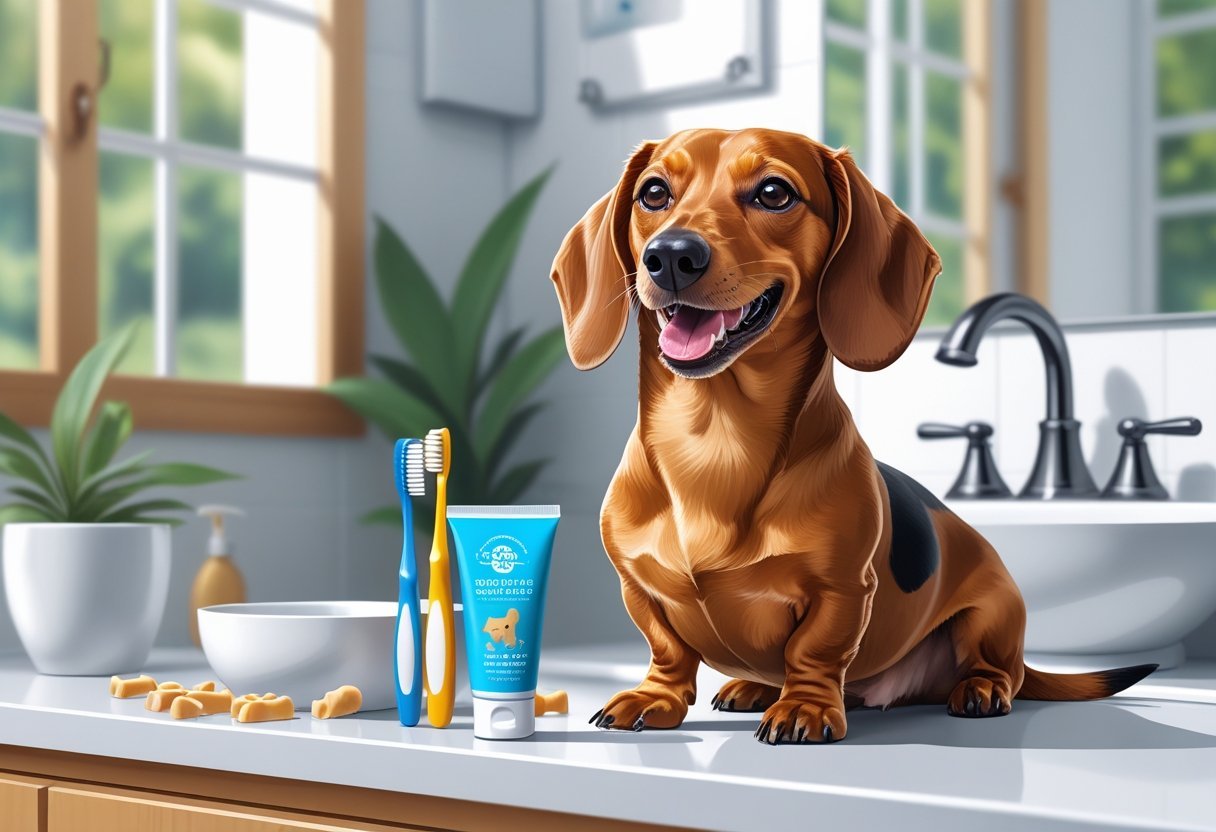Dachshunds stand out for their long bodies and quirky looks 🐾. But a lot of owners don’t realize these pups can run into some tough eye problems 👀.
Spotting eye issues early in dachshunds really helps protect their vision and health 🩺. Even small changes in how your dog acts or how their eyes look might be the start of something bigger ⚠️.
Cataracts, dry eye, and infections are all pretty common for dachshunds. If you see cloudiness, redness, or notice your dog squinting a lot, it’s probably time to pay attention 🔍.
Quick action and regular checkups go a long way in keeping your dachshund’s eyes healthy 🌟.
Key Takeaways ✨
- Keep an eye out for changes in your dachshund’s eyes or behavior. 🐕
- Early care and regular vet visits can help prevent serious eye issues. 🏥
- Simple habits at home make a difference for your dachshund’s eye health. 🏡
🐾 Free Dachshund Care Guide
Download our free checklist to ensure your Dachshund stays happy, healthy, and well-loved!
Get Your Free Guide 🐶Common Dachshund Eye Problems
Dachshunds face a bunch of serious eye problems through their lives 🐾. Some of these cause pain, vision loss, or might even need surgery ⚠️.
Progressive Retinal Atrophy 🌙
Progressive Retinal Atrophy (PRA) is a genetic disease. It slowly kills off the cells in the retina at the back of your dachshund’s eyes, leading to permanent vision loss over time 😢.
Early signs can be trouble seeing in the dark or dim rooms. Later, even daylight vision gets worse 🌤️.
PRA always affects both eyes. There’s no cure, which is honestly tough 💔.
Your dachshund might bump into things or get startled easily. A vet can spot PRA with a special eye exam or genetic test 🩺.
While you can’t treat PRA, you can help your dog adjust. Try not to move furniture around and avoid big changes at home 🏡.
If you’re breeding your dachshund, definitely consider genetic testing for PRA so you don’t pass it on 🧬.
Cataracts in Dachshunds 👁️
Cataracts make the lens of the eye cloudy. For dachshunds, this means vision gets blurry or foggy, sometimes in one eye, sometimes both 🌫️.
Cataracts pop up more often in older dachshunds, but genetics can play a role too. You might see cloudy or bluish eyes, your dog bumping into things, or just struggling to see 👀.
Eye injuries or diabetes can also cause cataracts. A vet will check for cataracts during an eye exam 🩺.
Small cataracts might not bother your dog much, but bigger ones can cause blindness. If your dog’s healthy enough, surgery can remove the cloudy lens and bring back sight ✨.
Leaving cataracts untreated can lead to problems like glaucoma, which is painful 😖.

👁️ Innovet Eye Support – Protect & Nourish Your Dachshund’s Eyes
Support your dachshund’s eye health with a gentle formula designed to keep their vision clear and strong. Perfect for dogs prone to eye irritation or age-related issues.
- Promotes healthy tear production and eye comfort 🌿
- Helps reduce irritation and cloudiness over time 😊
- Easy-to-use daily support for sensitive dachshund eyes 🐾
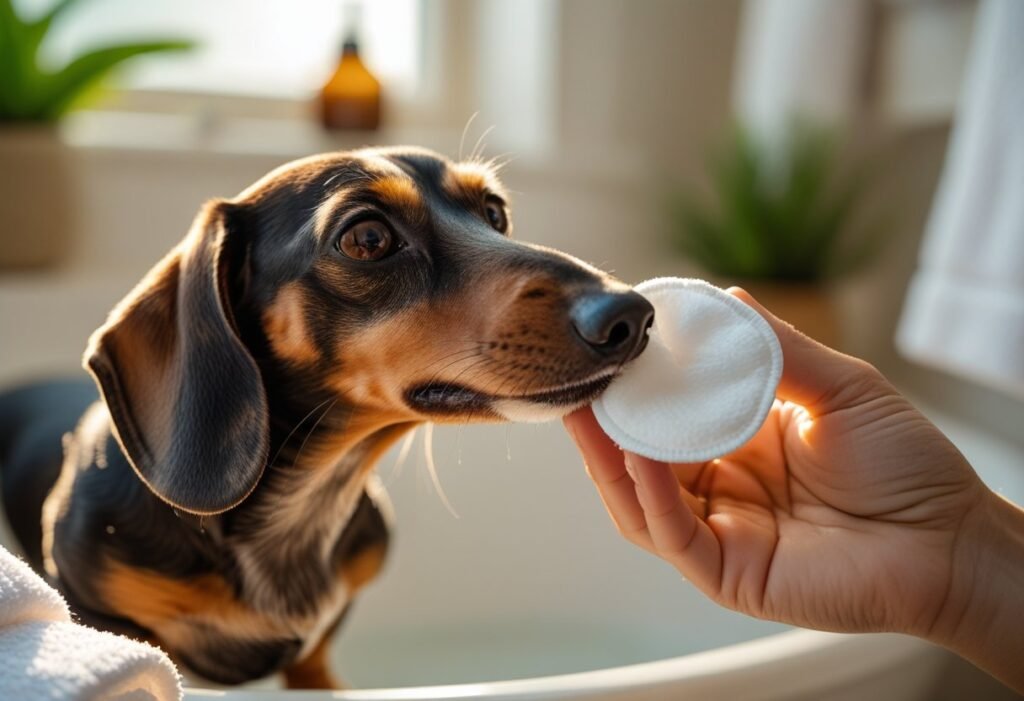
Dry Eye Syndrome 💧
Dry Eye Syndrome, or Keratoconjunctivitis Sicca (KCS), happens when your dachshund’s eyes don’t make enough tears. Their eyes dry out, get red or irritated, and start producing thick gunk 😕.
It’s pretty common in dachshunds and can get uncomfortable fast. If you ignore it, your dog might end up with infections or corneal ulcers 🦠.
Look for redness, squinting, pawing at the eyes, or sticky discharge. A vet will check tear production to diagnose dry eye 🩺.
Treatment usually means daily eye drops to keep things moist and comfortable.
Main treatment options for Dry Eye:
- Artificial tear drops 🧴
- Prescription ointments 💊
- Sometimes surgery ⚙️
Most dachshunds need long-term care for dry eye to stay comfortable 🌟.
Cherry Eye 🍒
Cherry eye happens when the tear gland in your dachshund’s third eyelid pops out. It looks like a red, round bump in the corner of your dog’s eye 🔴.
They call it “cherry eye” for a reason—it really is red and swollen. Young dogs get it more often, and it can show up in one or both eyes 🐶.
Cherry eye doesn’t usually hurt, but it can irritate the eye and mess with tear production. It won’t go away on its own 🚫.
Surgery is the way to fix cherry eye and avoid long-term issues. Removing the gland isn’t a good idea, since that can cause dryness later on 🩺.
If you spot red swelling in the corner of your dachshund’s eye, get it checked out quickly. The sooner you treat it, the better ⚡.
Recognizing Symptoms of Eye Issues
Dachshunds can get eye problems that show up in pretty obvious ways 🐾. If you watch your dog’s eyes and behavior closely, you’ll catch things early 👀.
Warning Signs to Watch For ⚠️
Look for changes in your dachshund’s eyes. Common warning signs of eye trouble include:
- Redness 🔴
- Cloudiness 🌫️
- Swelling 💢
- Visible discharge (clear, yellow, or green) 💧
- Squinting or keeping one eye closed 😣
If your dog’s eyes look dull or suddenly change color, pay attention. Sometimes the eye looks bigger or smaller than usual 👁️. The third eyelid might show, or the eye could look sunken or bulging.
Blinking a lot or struggling to open the eye fully? That’s a vet visit waiting to happen 🩺.

🥗 Wild Earth Vegan Complete Protein Dog Food
- Clean, plant-based recipe for healthier eyes and body 🌱
- Gentle on sensitive tummies and promotes overall wellness 🐾
- Supports long-term vision health with complete nutrition 😊

🍲 ChefPaw Dog Food Maker
- Make fresh, preservative-free meals at home 🏡
- Customize recipes for your dachshund’s eye health 🌟
- Budget-friendly and perfect for picky eaters 😋
Behavioral Changes Related to Vision 🐕
When dachshunds have vision problems, their behavior often shifts. You might see your dog bumping into furniture or walls 🛋️.
They may hesitate at stairs or when jumping. Some dogs act nervous in new places or start avoiding bright light 🌟.

If your dachshund seems more anxious at night, that could be a clue 🌙. They might get clingy, yelp when startled, or have trouble finding food or toys.
Even if their eyes look normal, changes in confidence or movement can point to vision problems 🐾.
Differences Between Acute and Chronic Problems ⏱️
Symptoms can appear suddenly (acute) or creep up over time (chronic). Acute problems might show up as a red, painful eye overnight, heavy squinting, or sudden blindness. These need fast attention from a vet 🚨.
Chronic issues develop slowly. Your dog might have constant tearing, slow color changes, or gradual cloudiness 🌫️.
They might just adapt to losing vision, so it’s easy to miss at first. Even if it doesn’t seem urgent, don’t ignore chronic symptoms ❗
Acute Symptoms vs Chronic Symptoms:
| Acute Symptoms | Chronic Symptoms |
|---|---|
| Sudden redness 🔴 | Ongoing cloudiness 🌫️ |
| Extreme squinting 😣 | Slow color changes 🎨 |
| Rapid vision loss ⚡ | Mild, long-term discharge 💧 |
| Severe swelling 💢 | Gradual behavior shifts 🐾 |
Causes and Risk Factors

Dachshunds can get eye problems for a bunch of reasons 🐾. Genetics, age, or just stuff in their environment can all play a part 🌍.
Genetic Predispositions 🧬
Dachshunds are born with a higher risk for several eye disorders. Progressive retinal atrophy (PRA) is a big one—if a puppy’s parents have it, the puppy’s more likely to get it too ⚠️.
Cataracts and dry eye can also be inherited. Sometimes these show up early, sometimes later ⏳.
Dogs with dappled (merle) coats—especially double dapples—face a higher risk for serious problems like microphthalmia, which means the eyes are too small 👁️.
Genetic screening and careful breeding can cut down on these risks. Early vet check-ups help catch issues before they get worse 🩺.
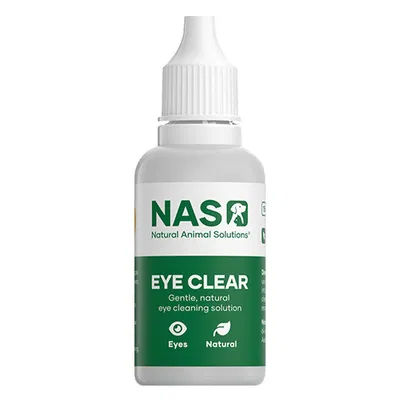
💧 Natural Animal Solutions Eye Clear
- Gently removes dirt and tear stains from delicate eyes 🌼
- Soothes irritation and helps prevent infections 🐾
- Safe, natural formula for everyday use 😌

🍽️ Petlibro Auto Feeder
- Provides consistent meal times for better health ⏰
- Reduces stress and keeps digestion on track 🐾
- Perfect for maintaining a balanced diet daily 🥗
Age-Related Changes ⌛
Getting older just makes eye problems more likely. Senior dachshunds often develop nuclear sclerosis, which makes the eyes look cloudy but doesn’t usually mess with vision much 🌫️.
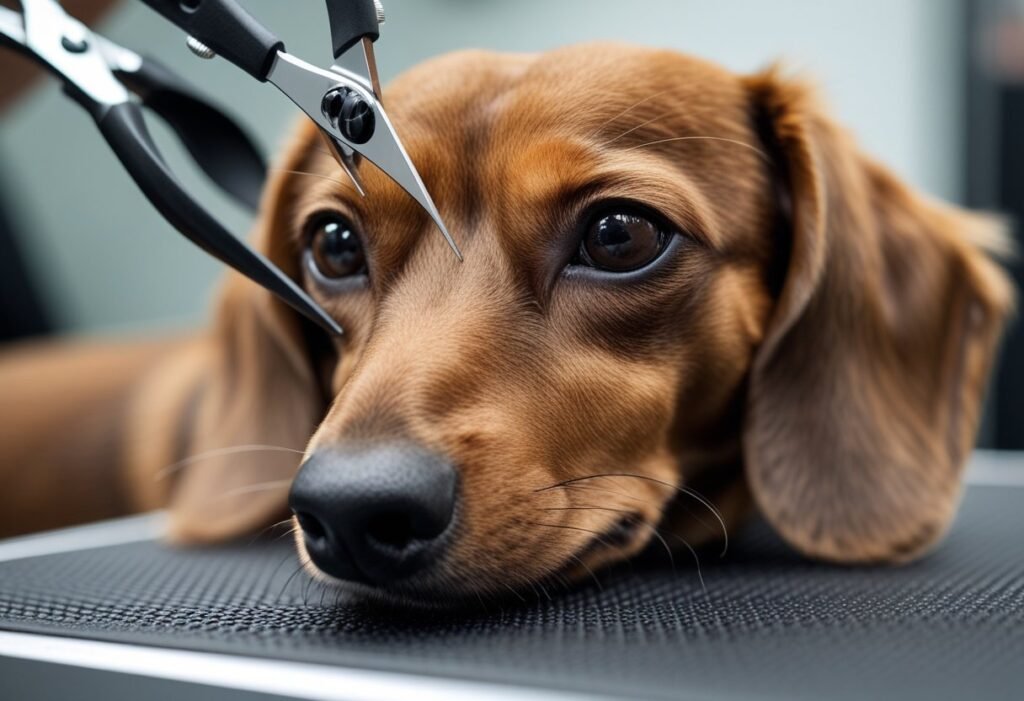
🎉 Grab your free Dachshund care checklist!
Older dogs can get real cataracts too, and these can block vision if left alone. The lens and other parts of the eye get less flexible, so focusing gets tougher 👀.
Glaucoma, which is high eye pressure, can show up with age and lead to pain or blindness. Regular vet visits are key because catching these early makes a big difference 💡.
Environmental Irritants 🌱
Lots of things in your dachshund’s world can bother their eyes. Smoke, dust, pollen, or harsh chemicals all make eyes red and watery 💧.
If your dog paws at their face, squints, or tears up a lot, something’s probably irritating them. Sharp grass, sand, or dirt can scratch their eyes when they’re out for a walk or playing 🌾. Scratches can turn into infections 🦠.
Poor air quality or strong-smelling sprays and perfumes can make things worse. Try to keep your home clean, limit smoke, and wipe your dog’s face after being outside 🏡.
If you see signs of irritation that don’t go away after a day, check with your vet 🩺.
Proper Eye Care for Dachshunds
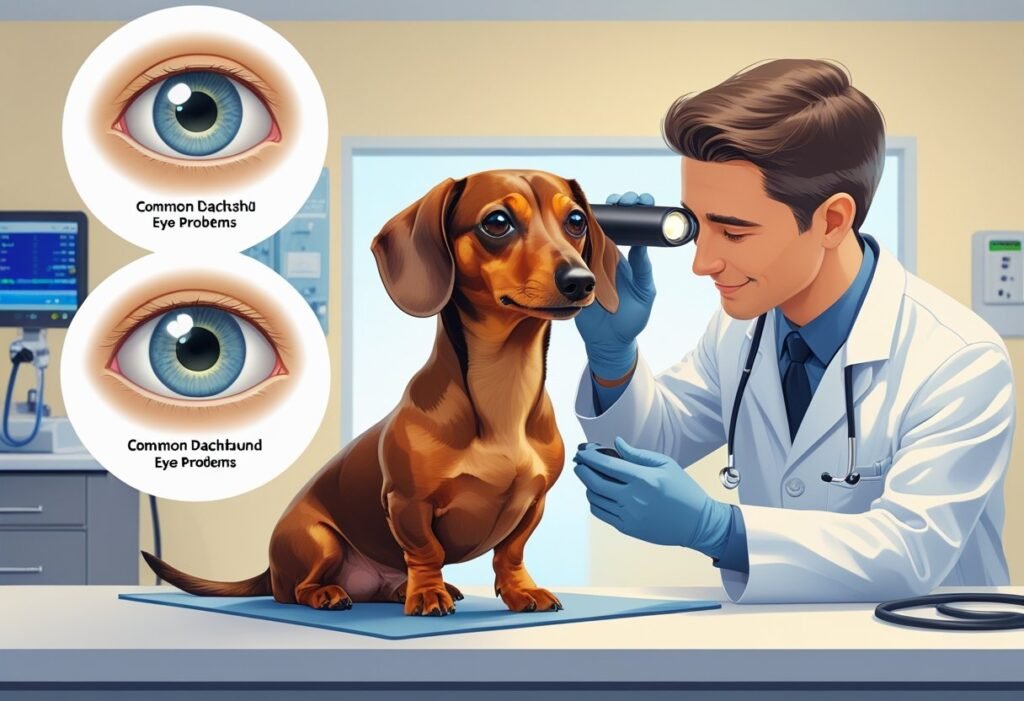
Dachshunds are just more likely to have certain eye issues, so you’ve really got to check and care for their eyes regularly 🐾. Clean habits and avoiding common irritants help prevent discomfort or bigger problems down the road 🌟.
Routine Eye Examinations 👁️
Routine eye checks matter if you want to catch health problems early. Take a look at your dachshund’s eyes every day 🔍.
Watch for redness, extra tears, swelling, cloudiness, or if your dog keeps pawing at its eyes 🐕.
Book a vet visit for a full eye exam at least once a year. Dachshunds, especially as they age, might need vet checks more often or if you spot any changes 🩺.
Keep notes on any eye issues or treatments. Vets often check for cataracts, glaucoma, and retinal problems in dachshunds 📋.
Early treatment can really help save your dog’s sight ✨.
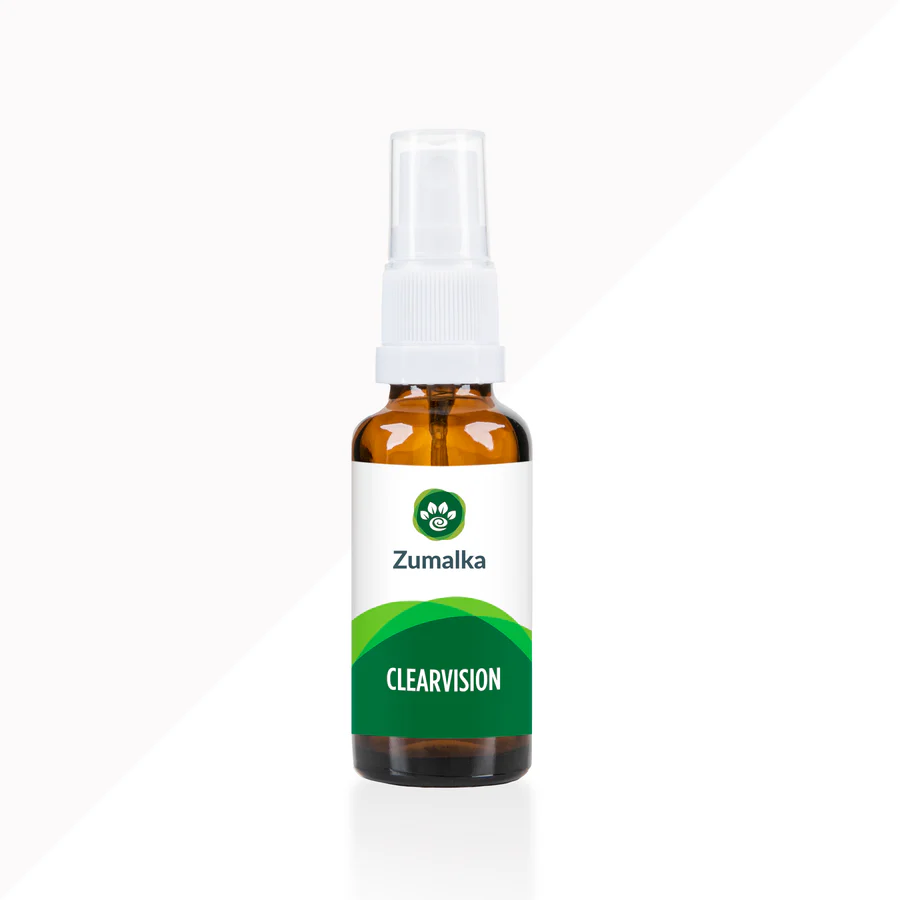
🌼 Zomalka Eye Care Support
- Gentle, natural support to soothe irritated eyes 🙂
- Pairs well with cleaning routines for daily comfort 🐾
- Helps reduce watering and mild redness over time 💧
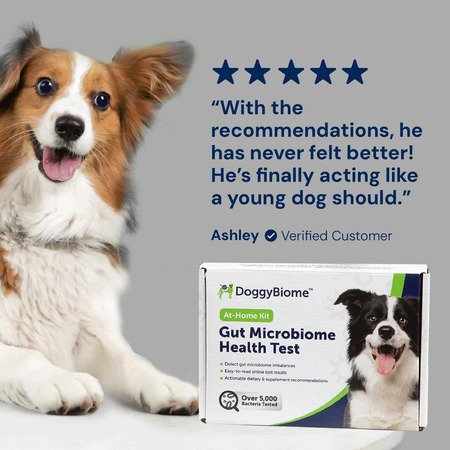
🔬 AnimalBiome Gut Health Test Kit
- At-home test to check gut balance that affects immunity 🌟
- Insights to fine-tune diet for healthier skin and eyes 🥗
- Simple process with clear, vet-backed reports 📄
How to Clean Dachshund Eyes 🧼
Cleaning your dachshund’s eyes helps get rid of dirt, mucus, or crust that collects in the corners. Here’s how to do it:
- Wash your hands before you touch your dog’s face. 👐
- Use a clean, soft cloth or damp cotton ball. Moisten it with lukewarm, clean water or a vet-approved rinse. 💧
- Wipe gently from the inside corner to the outside corner of the eye. Don’t rub hard. 😌
- Use a new cloth or cotton ball for each eye so you don’t spread germs. 🧴

Don’t use human eye drops or soaps. If you see yellow or green discharge, call your vet. Normal eye gunk is clear or maybe a little brown. 📞
Removing buildup daily keeps your dachshund comfortable and makes it easier to spot problems early 🌼.
Minimizing Eye Irritants 🌱
Dachshunds’ eyes are close to the ground, so they pick up dust, pollen, dirt, and other irritants on walks 🚶♂️.
Try these steps to cut down on exposure:
- Clean bedding and toys often so dust doesn’t build up. If allergies are an issue, talk to your vet about ways to keep your dog’s eyes comfortable. 🐶
- Keep grass trimmed and clear paths of debris. ✂️
- Don’t let your dachshund stick its head out of car windows. 🚗
- Avoid scented cleaners, sprays, or harsh chemicals near your dog. 🧴
- Use pet-safe shampoos and rinse really well after baths. 🛁
Watch out for things around the house or yard—like air fresheners or fertilizers—that can bother their eyes. 🏡
Clean bedding and toys often so dust doesn’t build up. If allergies are an issue, talk to your vet about ways to keep your dog’s eyes comfortable. 🐶
Treatment Options for Eye Conditions
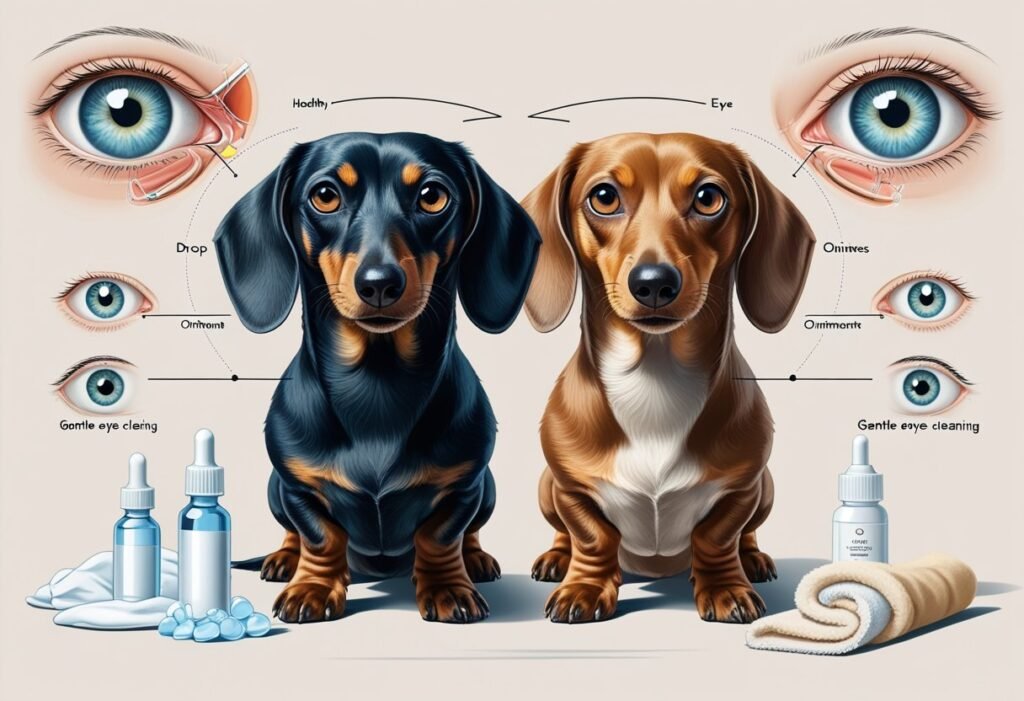
There are several ways to manage eye problems in dachshunds 🐾. Your vet will pick a treatment based on what’s going on and how severe it is 🩺.
Medications and Topical Treatments 💊
For many dachshund eye issues—conjunctivitis, dry eye, or early cataracts—your vet might prescribe medications or topical treatments. These usually come as eye drops, gels, or ointments to cut inflammation, fight infection, or help with tear production 👁️.
Common medications for eye conditions include:
- Antibiotic drops or ointments for bacterial infections 💧
- Steroid drops for inflammation (but not for ulcers) 🧴
- Artificial tears for chronic dry eye 😌
- Anti-glaucoma drops to lower eye pressure ⚖️
Stick to your vet’s instructions about dosage and timing. Some medicines need to be given several times a day, and missing doses can slow things down ⏱️.
Your vet will show you how to apply drops safely and what changes to watch for in your dog’s eyes 🐶.

🛡️ The Swiftest Insurance Comparison Tool
- Compare plans fast—be ready for eye emergencies ⚠️
- Find fair coverage for exams, meds, and surgery 💊
- Peace of mind when symptoms appear suddenly 💡

🎯 Brain Training for Dogs
- Teach calm behaviors to reduce eye rubbing 🙂
- Improve confidence in low-light or new spaces 🌙
- Fun indoor games to prevent risky zoomies 🎮
Surgical Interventions ⚙️
Sometimes, medication just doesn’t cut it and surgery is needed. Dachshunds might need surgery for severe cataracts, deep corneal ulcers, or advanced glaucoma 🚨.
Typical procedures include:
- Cataract removal surgery to restore vision ✨
- Corneal grafting for deep ulcers 🩹
- Enucleation (removal of the eye) for severe pain or tumors ❗
- Laser surgery for certain glaucoma cases 🔦

Surgical choices depend on your dog’s age, health, and the exact problem. Recovery is usually quick, but you’ll need to give special care after surgery—protecting the eye and giving any prescribed meds 🛏️.
Your vet will walk you through what to expect 🤝.
Long-Term Management Strategies 🌱
Chronic or recurring eye conditions need ongoing care. Sometimes that means giving eye drops daily or watching closely for early signs of infection or irritation 🔍.
Key steps for managing things long-term:
- Regular check-ups to monitor eye health and catch problems early 🩺
- Daily cleaning to remove discharge 🧼
- Consistent medication routines for issues like dry eye or glaucoma 💧
You might need to tweak your dachshund’s environment—use soft bedding or avoid dusty places and sharp plants 🐕.
Preventive Measures and Health Maintenance
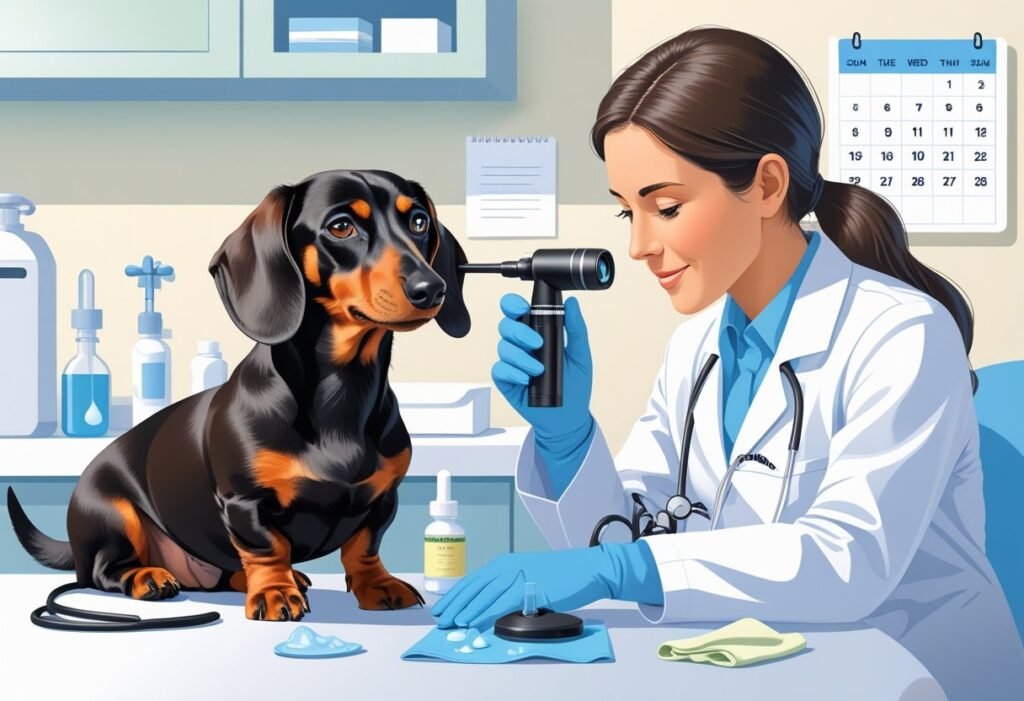
Taking care of your dachshund’s eyes means making smart choices every day 🐾. Paying attention to their diet, safety, and regular check-ups can lower the risk of big problems down the road 🩺.
Diet and Nutritional Support 🥕
Your dachshund’s diet affects eye health in more ways than you might think. Good nutrition keeps the eyes strong and boosts the immune system 🌟.
Look for foods rich in vitamin A, omega-3 fatty acids, zinc, and vitamin C. You can pick a high-quality dog food with these nutrients or chat with your vet about safe supplements 🍎.
Skip foods with fillers and artificial stuff—they usually don’t offer enough nutrition. Stick to a regular feeding schedule and keep your dog at a healthy weight ⚖️.
Extra weight can lead to diabetes, which can cause eye issues like cataracts. Always provide fresh water and avoid giving human foods that are harmful, like onions or chocolate 🚫.
Nutrient Table:
| Nutrient | Beneficial For | Food Sources |
|---|---|---|
| Vitamin A | Night vision, dryness 🌙 | Liver, carrots 🥕 |
| Omega-3 Fatty Acids | Reduces inflammation 💧 | Fish oil, flaxseed 🌾 |
| Zinc | Healing, protection 🛡️ | Meat, whole grains 🍞 |
| Vitamin C | Antioxidant support 🍊 | Berries, green veggies 🥦 |
🏡 Comfort & Safety Essentials for Healthy Dachshund Eyes
- 🛏️ Majestic Pet Orthopedic Bed — Give your Doxie a cozy, supportive rest spot to reduce stress and keep their body comfortable while healing.
- 📹 Petcube Cam 360 — Keep an eye on your Dachshund’s behavior and catch early signs of eye irritation, even when you’re away.
- 📍 Tractive DOG GPS Tracker — Track your Doxie’s location and prevent risky outdoor adventures that could lead to eye injuries.
- 🐾 Pride + Groom Grooming Tools Kit — Gentle grooming tools to keep fur around the eyes clean and prevent irritation.
Preventing Eye Injuries 🛡️
Prevent eye injuries by making your home and yard safer. Clear sharp objects and trim bushes at your dog’s eye level ✂️.
If your dachshund loves to dig or race through tall grass, try an adjustable dog visor or eye protection for outdoor adventures 🌱.
Check your dog’s face and eyes daily for dirt, cuts, or redness. Wipe away any discharge with a clean, damp cloth 🧼.

Teach kids to play gently. Don’t let your dachshund hang its head out the car window—blowing debris can hurt their eyes 🚗.
Using a harness instead of a collar can help avoid neck strain and injuries during walks 🐕.
Breeder and Veterinary Screening 🧬
If you’re picking out a dachshund puppy, ask the breeder for eye health test results. Good breeders screen for genetic eye diseases like progressive retinal atrophy (PRA) and cataracts 🐶.
Once your pup is home, set up regular vet visits for full eye exams. Vets may use drops and simple tests to check for dryness, ulcers, or hidden infections 🩺.
If you see any changes—watery eyes, cloudy lenses, or squinting—tell your vet right away. Early detection gives your dog a better shot at successful treatment ✨.
When to Consult a Veterinarian
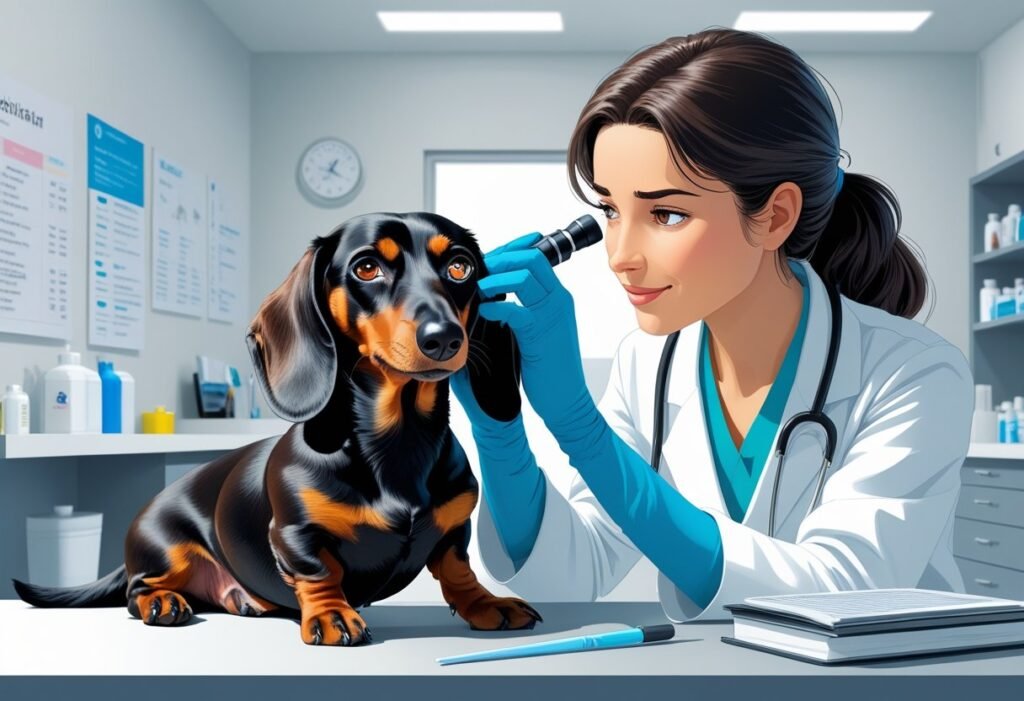
Some dachshund eye problems need fast medical help, while others just need regular checkups 🐾. Knowing the difference can help keep your dog’s eyes healthy 👁️.
Emergency Symptoms 🚨
There are certain signs that mean your dachshund needs to see a veterinarian right away. If you notice any of these, don’t wait:
- Sudden swelling or bulging of the eye 💢
- Eye is red, cloudy, or bleeding 🔴
- Thick green or yellow discharge 💧
- Your dog can’t open its eye 😣
- Squinting or rubbing the eye all the time 👋
- Your dog bumps into things or seems blind ⚠️
Quick action can help save your dog’s vision. Waiting too long ups the risk of permanent damage. If you’re not sure, call your vet or an emergency clinic for advice 📞.
💛 Extra Care & Comfort for Your Dachshund’s Eye Health
- 🎽 Embark Pet No-Pull Harness – Gentle, strain-free walks to keep eye injuries at bay
- 🛏️ Majestic Pet Pet-Stairs – Easy climbing access to prevent accidental bumps or falls
- 💧 Petlibro Water Fountain – Fresh flowing water to support overall health and tear production
- 🛁 Pride + Groom “The Sensitive One” Shampoo – Gentle cleansing around sensitive eye areas
- 🎨 Purr & Mutt Personalized Dachshund Art – A heartfelt keepsake celebrating your pup’s journey
🐾 Keep your Doxie safe, comfortable, and happy with thoughtful care choices every day.
Routine Veterinary Care for Eye Health 🩺
Even if you don’t see emergency symptoms, set up routine eye checks at least once a year. Dachshunds are prone to some eye diseases that you can catch early with regular exams 🌟.
At your appointment, the vet may:
- Check for cataracts and signs of glaucoma 👀
- Examine the retina and other eye structures 🔍
- Test for dry eye 💧
- Give advice about cleaning and medications 🧼
If you notice any changes in your dog’s eyes between visits, mention them at your next appointment 🐶.
🐾 Don’t Miss Out!
Download our free Dachshund care guide to keep your furry friend happy and healthy.
Get Your Free Guide 🐶Frequently Asked Questions

Dachshunds can develop all kinds of eye problems, and a lot of them show up with visible signs 🐾. Learning about symptoms, causes, and care steps can help you keep your dog’s eyes healthy 👁️.
What are the symptoms of Progressive Retinal Atrophy (PRA) in dachshunds? 🌙
Early PRA symptoms include trouble seeing in low light or at night. Your dog might bump into things more often ⚠️.
As PRA gets worse, vision loss increases, and your dachshund may have cloudy eyes or act confused in new places 😕.
How can you tell if your dachshund is experiencing vision problems? 🔍
Watch for red eyes, cloudiness, or frequent eye rubbing. Your dog may hesitate in new places or seem startled by objects 🚪.
Behavior changes, like clumsiness or fear of dark spaces, can also mean vision issues 🌙.
What are the common causes of eye discharge in dachshunds? 💧
Eye discharge can come from allergies, infections, or blocked tear ducts. Some dachshunds get discharge because of eyelid problems or dry eye 🌱.
If the discharge is thick, green, or yellow, it could be an infection 🦠.
Are dachshunds prone to any hereditary eye conditions? 🧬
Dachshunds are more likely to inherit PRA, cataracts, and sometimes glaucoma. These conditions can pass from parent dogs to puppies 🐶.
Genetic screening is available to help breeders lower the risk 🩺.
What steps can be taken to prevent eye problems in miniature dachshunds? 🐾
Take your dachshund to the vet for regular check-ups. This helps you catch eye issues early, before they turn into bigger problems ✨.
Keep the hair around your dog’s eyes trimmed, and gently clean their face. That way, you can cut down on irritation from fur or dirt 🧼.
Feed your pup a healthy diet. Also, try to prevent any bumps or injuries to their head or eyes—easier said than done sometimes, but it matters for their vision ⚡.
How should you care for a dachshund with an eye condition? 🩺
Give medicines just like your vet tells you. Keep your dog’s eyes clean, even if they squirm a bit during the process 😣.
Try to keep them away from dust or wind. If your dachshund keeps scratching, you might need to use an Elizabethan collar—yeah, those silly cones 🐕.
Check in with your vet for follow-up exams. That way, you’ll catch any changes or new problems before they get worse 🌟.



